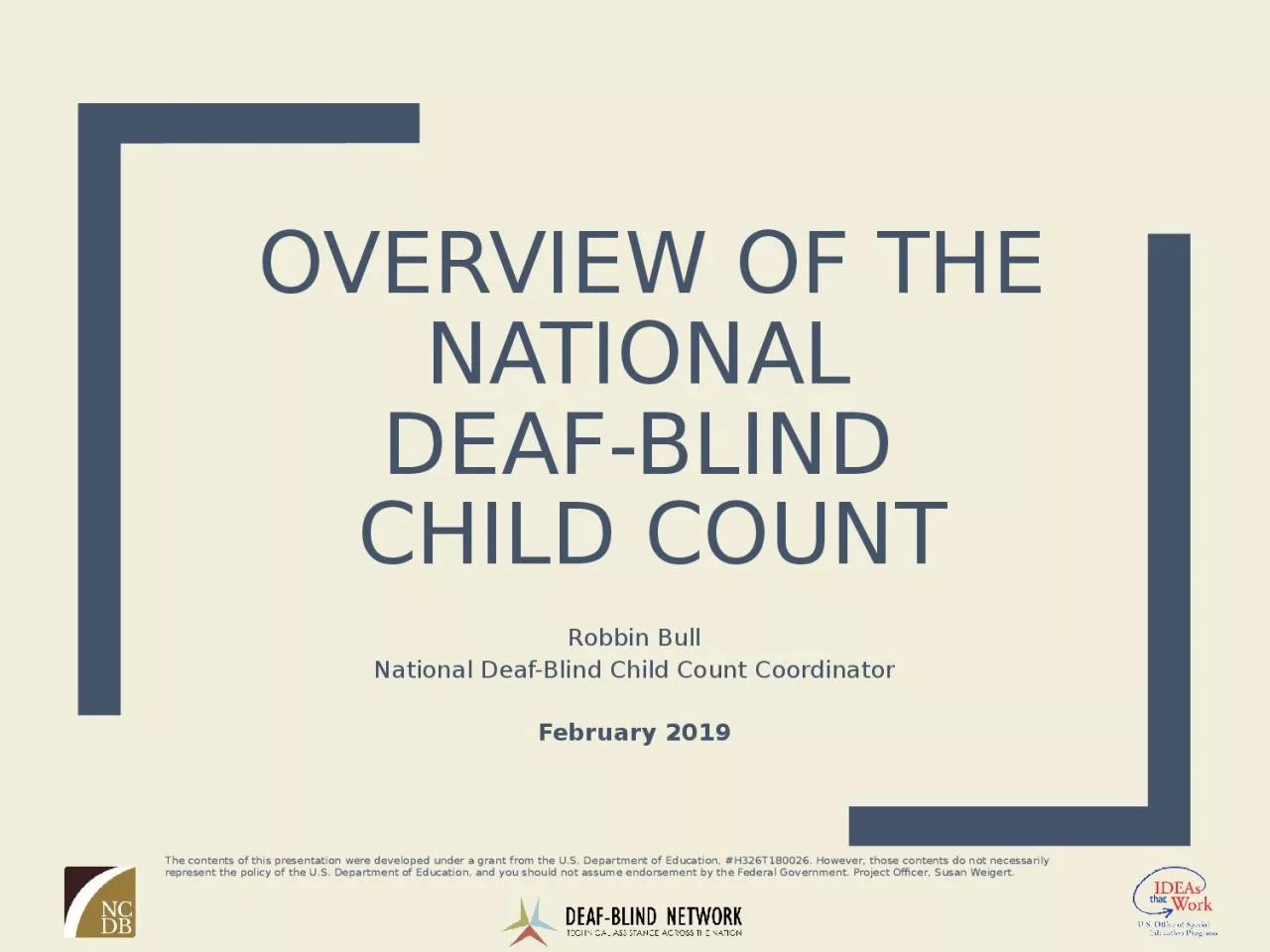

deafblind child count Robbin Bull National DeafBlind Child Count Coordinator February 2019 The contents of this presentation were developed under a grant from the US Department of Education H326T180026 However those contents do not necessarily represent the policy of the US Departm ID: 933727
Download Presentation The PPT/PDF document "Overview of the National" is the property of its rightful owner. Permission is granted to download and print the materials on this web site for personal, non-commercial use only, and to display it on your personal computer provided you do not modify the materials and that you retain all copyright notices contained in the materials. By downloading content from our website, you accept the terms of this agreement.
Slide1
Overview of the National deaf-blind child count
Robbin BullNational Deaf-Blind Child Count CoordinatorFebruary 2019
The contents of this presentation were developed under a grant from the U.S. Department of Education, #H326T180026. However, those contents do not necessarily represent the policy of the U.S. Department of Education, and you should not assume endorsement by the Federal Government. Project Officer, Susan Weigert.
Slide2Historical review
Slide3History of the Annual Child Count
The annual National Child Count of Children and Youth who are Deaf-Blind (Birth –21) has been conducted since 1986.It represents a “snapshot” count on December 1st of each year to supplement OSEP’s federal Child Count, which includes children as deaf-blind when deaf-blindness represents their only disability.
It is the first, and longest running, registry and knowledge base for children who are deaf-blind.
Slide4Comprehensive set of demographics, such as..
Age distribution, ethnicity, and primary etiologyDocumented vision and hearing lossPrimary IDEA classification categories and additional disabilitiesIDEA special education status
IDEA placement and living settings
Slide5Why do we collect this information?
To assure current and accurate state-level needs assessment data is available and used in the design and delivery of TA and to inform current research needs and personnel preparation.So that…all children who are deaf-blind are getting the highest quality services available to meet their individual needs.
Slide6Questions we seek to answer
Who are the children and youth with deaf-blindness throughout the country and how many are there?What is the relationship of the Deaf-Blind Child Count (DBCC) to the IDEA Part B and Part C Annual Child Counts?What is the extent of the vision and hearing losses of those reported on the DBCC, and what additional disabilities do they manifest?
Where are those reported receiving services and what types of supports are they receiving, and how does this impact technical assistance and training needs?Where are they living and how does this impact technical assistance and training needs?
Slide7Census over time
Slide8“Snapshot in time”Since 2003 we include only those who are in
SpEd and eligible to receive SDBP services on December 1 each yearFirst table only shows those eligible to receive state deaf-blind project services on December 1, regardless of whether they are in Part C or Part B.
Slide9Relationship to Part B and Part C2003 - Part B and C exiting data elements included (created “snapshot” count)
2006/2007 - Realignment of data elements with IDEA, section 618 data reporting requirements and changes in documentation procedures consistent with IDEA classification and reclassification regulatory changes2007 – IDEA definition of deaf-blindness adopted as consistent definition for DBCC2009 - Realignment of Part C codes with IDEA, section 618 data reporting requirements2010 – Race/Ethnicity updated to be consistent with new 618 requirements in IDEA 2004
Slide10Definition of deaf-blindness
IDEA 2004 definition of deaf-blindness states that:“Deaf blindness means concomitant hearing and vision impairments, the combination of which causes such severe communication and other developmental and educational needs that they cannot be accommodated in special education programs solely for children with deafness or children with blindness” For infants and toddlers receiving Part C early intervention services, deaf-blindness is defined as:
“Concomitant hearing and vision impairments or delays, the combination of which causes such severe communication and other developmental and intervention needs that specialized early intervention services are needed.”**Defined by NTAC/SDBP workgroup in 2006
Slide11National totals, 10 years
Slide12Age groups, 7 years
Slide13Documented FUNCTIONAL vision loss and hearing lossA Functional Vision Assessment is defined as
“a non-clinical assessment, carried out by a trained vision specialist using commonly accepted assessment tools, checklists and measures for making educated judgments about the functional use of vision.”A Functional Hearing Assessment is defined as “a non-clinical assessment carried out by a trained hearing specialist using commonly accepted assessment tools, checklists and measures for making educated judgments about the functional use of hearing.”
Slide14Current Data
Slide15Documented Vision loss, 2017
Slide16Documented Hearing Loss, 2017
Slide17Vision loss by hearing loss, 2017
Slide18Race/Ethnicity, 2017
Slide19Top Etiologies, 2017
Etiology
Count
Hereditary Syndromes/ Disorders
2552
Complication of Prematurity
1047
CHARGE Syndrome
933
Pre-Natal Congenital Complications
678
Post-Natal Non-Congenital
670
Usher Syndrome (I,II,III)
329
Down syndrome
315
Cytomegalovirus (CMV)
292
Microcephaly
214
Hydrocephaly
206
Asphyxia
194
Severe Head Injury
159
Stickler syndrome
137
Meningitis
137
Dandy Walker syndrome
115
Goldenhar
syndrome
101
Slide20Other Disabilities, 2017
Slide21Early Childhood and School Age Ed Setting, 2017
Slide22Intervener Services, 2017
Slide23Living Setting, 2017